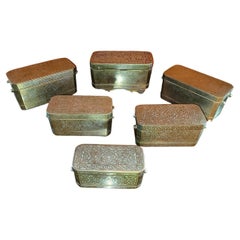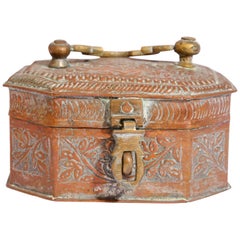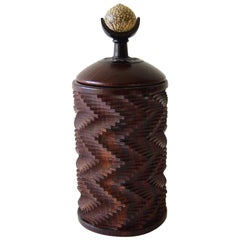Philippine Tea Caddies
to
1
1
1
1
1
1
1
3,618
391
302
228
50
Height
to
Width
to
1
1
1
Place of Origin: Philippine
Set of 6 Mindanao Brass Silver Betel Boxes, Philippines
Located in Dallas, TX
Presenting an amazing set of 6 Mindanao brass silver betel boxes, Philippines.
Betel chewing was prevalent in the southern Philippines as in much o...
Category
Late 19th Century Islamic Antique Philippine Tea Caddies
Materials
Silver, Brass, Copper
Related Items
Handcrafted Antique Tinned Copper Metal Betel Box, India
Located in North Hollywood, CA
Beautiful handcrafted antique tinned copper decorative octagonal betel box with with lid, handle and brass latch.
The metal is delicately and int...
Category
Early 20th Century Folk Art Philippine Tea Caddies
Materials
Brass, Copper, Tin
Jon Sauer California Modern Studio Exotic Woods Betel Nut Lidded Box
By Jon Sauer
Located in Palm Springs, CA
Zig zag patterned cocobolo, blackwood and betel nut lidded box created by Jon Sauer of San Francisco, California. Box measures 7" in height by 3" in diameter. In excellent vintage co...
Category
1980s Mid-Century Modern Vintage Philippine Tea Caddies
Materials
Cocobolo
$875 Sale Price
32% Off
H 7 in Dm 3 in
Burmese Lacquerware Betel Box
Located in New York, NY
Burmese antique lacquerware betel box. Individual Betel Box authentic Burmese Folk Art know as Kun- It, Mandalay Period. A lacquered cylindrical body of woven turned Bamboo decorated by incised lacquer overall with Chu-pan variant motif and traditional Folk Art characters. This Betel Box has four bowls that make up the entire box. This is a complete Burmese Lacquerware Betel Box.
Each bowl has a purpose. The top and base work as large containers and two shallow dishes work as small bowls. The workmanship is very unique having exquisite height details to the bottom of the base container and the two shallow bowls showcasing a complex design to the weaving. Antique Burmese Lacquerware is highly collectible, having books written on this Folk Art with museums having collections and exhibits of same. A very nice antique Burmese Betel Box...
Category
Early 20th Century Other Philippine Tea Caddies
Materials
Lacquer
Antique Southeast Asian Filipino Maranao Silver Inlaid Brass Betel Nut Box
Located in Forney, TX
A scarce fine quality antique silver-inlaid solid brass betel nut box (Lutuan), dating to the second half of the 19th / early 20th century, hand-crafted in Mindanao, Philippines.
Boxes such as this were used to store the areca nut (also known as the betel nut) which would be wrapped in a betel leaf with lime paste and other ingredients, often tobacco, for chewing. Similar to the European tea caddy, these boxes often served as a way to impress while showing off ones wealth.
Betel chewing was prevalent in the southern Philippines as in much of the rest of Southeast Asia. Wealthier Maranao families on Mindanao were able to afford elaborate silver-inlaid brass betel boxes such as this example. Such boxes were used to show off to guests and from which they were offered betel and the other component such as leaves and lime to make up the betel quid.
Rare large size, most extant examples of such boxes tend to measure around 5 inches in length. At slightly more than 7.75 inches the example here is larger than most.
The distinctive decorative box features a very heavy strong-box like rectangular shaped chest form with canted corners, copper handles, and a conforming hinged lid, lifting open to reveal an interior divided into three compartments covered by four hinged lids. Each of these doors is inlaid with silver in stylized orchid flower patterns.
Exceptionally executed throughout, the arabesque silver inlaid exterior is decorated to the top with a large orchid motif within scrolling obid-obid (stylized rope) borders. The front, back and sides are inlaid with sets of stylized tail feathers of the sari-manok bird beneath which are unusual, highly stylized whimsical zoomorphic faces that appear like cat or tiger faces. (Such stylisation is accounted for by Southeast Asian Islamic preferences to avoid the overt and this potentially idolatrous representation of animal and human forms. Designs such as these are drawn from a local design repertoire that has its origins in wood carving.
Although the spread of Islam in the Philippines began in the 14th century, mostly through the influence of Muslim merchants from the western Malay Archipelago, decorative arts in this design remain exceptionally rare. This lutuan represents a fine example of Islamic metalwork from the most eastern outreach of Islamic art and civilisation: Mindanao island being significantly further east than even China – artwork from Islamic Southeast Asia remains chronically under-represented in the world’s major collections of Islamic art.
PROVENANCE / ACQUISITION
Acquired from highly reputable auction house, Austin Auction Gallery, established 1983, Austin, Texas.
References
Brownrigg, H., Betel Cutters...
Category
19th Century Islamic Antique Philippine Tea Caddies
Materials
Silver, Brass, Bronze, Copper
$1,100
H 3.25 in W 7.75 in D 3.25 in
Rajasthani Mughal Decorative Copper Lidded Betel Spice Pandan Caddy Box
Located in North Hollywood, CA
Rajasthani Mughal Decorative Copper Lidded Betel Spice Pandan Caddy Box.
Handcrafted decorative North India round metal Asian copper Mughal Raj, Indian lidded , spice, pandan betel box with latch and a top handle.
Of dome form with lotus-shaped finial, with spiralling bosse designs,
Delicately and intricately hand-chased and hammered with geometric Anglo-Indian designs.
Consuming betel leaves with several ingredients such as wet lime paste, katechu, areca nut, cloves and even tobacco leaves has been popular in India from the fourth century AD.
The box was probably used to store the betel leaf used in the preparation of paan. Lime paste is mixed with grated areca nut and flavourings and the resulting mixture is rolled in the betel leaf to form a small parcel which can then be chewed. As well as being an integral part of Indian hospitality paan is believed to possess medicinal properties and was also taken as an aphrodisiac. The present box, which was elaborately designed for this purpose, would have been taken out ceremoniously on special occasions.
Exquisite conversation museum quality piece with a very nice antique patina.
Fine intricate artwork with conical form lid with Moorish pierced designs.
Islamic Mughal Indo Persian...
Category
Late 19th Century Agra Antique Philippine Tea Caddies
Materials
Brass, Copper
Set of Brass Apple Jewelry Boxes 1970s
Located in ROUEN, Normandie
Set of Brass Apple Jewelry Boxes 1970s.
These apple-shaped boxes are entirely made of solid brass.
Each box opens in two and allows for a very decor...
Category
Mid-20th Century Mid-Century Modern Philippine Tea Caddies
Materials
Bronze, Brass
Antique Burmese Orange Lacquer Round Betel Box, c. 1900, Burma
Located in Austin, TX
An attractive antique Burmese cylindrical orange and black lacquered bamboo betel box, kun-it, with interior tray, early 20th century, circa 1910, Burma (Myanmar).
The visually str...
Category
1910s Vintage Philippine Tea Caddies
Materials
Lacquer, Bamboo
Betel Nut Box from Java with Polychromed Finish, Indonesia, c. 1900
Located in Jimbaran, Bali
Betel Nut is consumed on a daily basis in a large portion of the Indonesian Archipelago. In Java, betel nut was offered as a sign of respect and hospitality when people would visit o...
Category
Early 20th Century Tribal Philippine Tea Caddies
Materials
Hardwood
$260 Sale Price
20% Off
H 3.23 in W 8.47 in D 5.12 in
Persian Enameled Painting Silver Box
Located in Guaynabo, PR
This is a large squared shaped Persian enameled painting silver box. It depicts a scene of a Persian family with the parent seated and their three child...
Category
20th Century Islamic Philippine Tea Caddies
Materials
Silver
A Mindanao silver inlaid bronze betal nut box, Islamic, mid to late 19th century
Located in Central England, GB
This highly decorative box is a betal nut box. The habit of chewing was relevant in the southern Philippines and much of southeast Asia. Wealthy Maraneo families on the island of Mi...
Category
Late 19th Century Tribal Antique Philippine Tea Caddies
Materials
Silver
$2,966
H 5.32 in W 9.45 in D 3.94 in
Asian Handcrafted Oval Betel Box in Metal Silvered
Located in North Hollywood, CA
Asian decorative trinket lidded box in metal silvered hammered and etched with organic floral design.
Anglo Raj style oval form betel box.
Dimensio...
Category
Mid-20th Century Anglo Raj Philippine Tea Caddies
Materials
Metal
Betel Nut Box from Java with Polychromed Finish, Indonesia, c. 1900
Located in Jimbaran, Bali
Betel Nut is consumed on a daily basis in a large portion of the Indonesian Archipelago. In Java, betel nut was offered as a sign of respect and hospitality when people would visit o...
Category
Early 20th Century Tribal Philippine Tea Caddies
Materials
Hardwood
$260 Sale Price
20% Off
H 3.35 in W 8.67 in D 4.61 in


